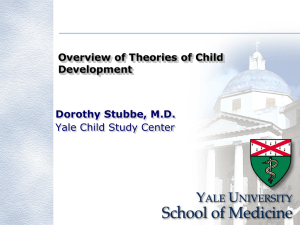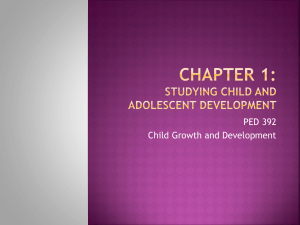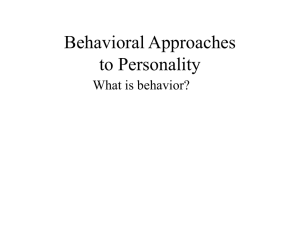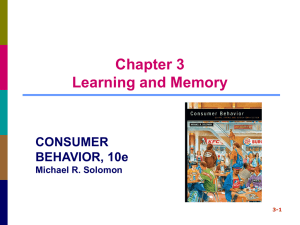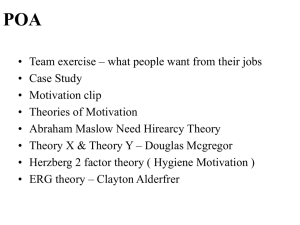Behaviorism
advertisement
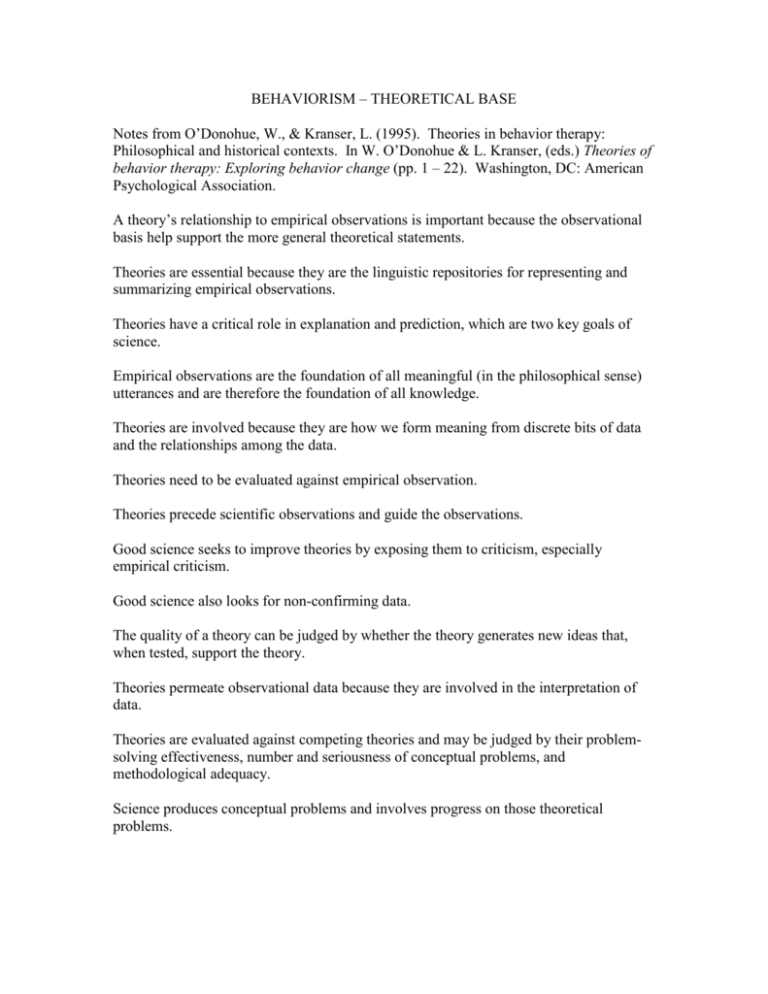
BEHAVIORISM – THEORETICAL BASE Notes from O’Donohue, W., & Kranser, L. (1995). Theories in behavior therapy: Philosophical and historical contexts. In W. O’Donohue & L. Kranser, (eds.) Theories of behavior therapy: Exploring behavior change (pp. 1 – 22). Washington, DC: American Psychological Association. A theory’s relationship to empirical observations is important because the observational basis help support the more general theoretical statements. Theories are essential because they are the linguistic repositories for representing and summarizing empirical observations. Theories have a critical role in explanation and prediction, which are two key goals of science. Empirical observations are the foundation of all meaningful (in the philosophical sense) utterances and are therefore the foundation of all knowledge. Theories are involved because they are how we form meaning from discrete bits of data and the relationships among the data. Theories need to be evaluated against empirical observation. Theories precede scientific observations and guide the observations. Good science seeks to improve theories by exposing them to criticism, especially empirical criticism. Good science also looks for non-confirming data. The quality of a theory can be judged by whether the theory generates new ideas that, when tested, support the theory. Theories permeate observational data because they are involved in the interpretation of data. Theories are evaluated against competing theories and may be judged by their problemsolving effectiveness, number and seriousness of conceptual problems, and methodological adequacy. Science produces conceptual problems and involves progress on those theoretical problems. Behavior therapy is rooted in an outer paradigm that focuses on the environment instead of an inner paradigm that focuses on biological functions, mind, genes, etc. Behavior therapy originally included variables such as feelings and thoughts. Quoting Skinner, “Behavior is what the organism is doing,” i.e. “achieve some kind of effect.” Further quoting Skinner, “[B]ehavior is selected by its consequences. In natural selection the consequences are the contribution the behavior makes to the survival of the species. . . . Operant conditioning is studied in the laboratory by arranging complex and subtle relations among setting, behavior, and consequences.” BEHAVIORISM BASICS 1. A behavior can be observed. 2. Unobservable events are not behaviors and are outside the scope of behaviorism. 3. Whether or not cognitions and emotions are behaviors is debated. Since they may be converted to communicative behaviors, they may be used in a behavioral model. 4. There’s no such thing as unmotivated behavior. 5. Behaviors are influenced by antecedents (stimuli) and consequences. 6. Behavioral patterns are learned. 7. Classical conditioning – pairing of a neutral stimulus with a reflexive response 8. Operant conditioning – changing a behavior (that operates on the environment) by pairing it with a response 9. Reinforcers strengthen behaviors. a. Positive Reinforcement = pleasant consequence = reward b. Negative Reinforcement = removal of unpleasant situation = reward 10. Punishers (= unpleasant consequence) weaken behaviors. 11. Non-reinforcement (= ignoring = no consequence) leads to extinction 12. Shaping = reinforcing successive approximations 13. Reinforcement may be intermittent 14. Reinforcement schedules a. Fixed Interval Schedules: the target response is reinforced after a fixed amount of time has passed since the last reinforcement. b. Variable Interval Schedules: similar to fixed interval schedules, but the amount of time that must pass between reinforcement varies. c. Fixed Ratio Schedules: a fixed number of correct responses must occur before reinforcement may recur. d. Variable Ratio Schedules: the number of correct repetitions of the correct response for reinforcement varies. 15. Variable interval and especially, variable ratio schedules produce steadier and more persistent rates of response because the learners cannot predict when the reinforcement will come although they know that they will eventually succeed. 16. According to social learning theory, people learn from the consequences they observe for the behavior of others, so vicarious reinforcement and punishment also influence behavior. 17. Reciprocal inhibition is the label for the phenomenon that a behavior inhibits its functionally opposed opposite. 18. Arnold Lazarus identifies seven modalities (BASIC – ID) to address in his multimodal behavior therapy. This is also known as technical eclecticism a. Behavior b. Affect c. Sensation d. Imagery e. Cognition f. Interpersonal Relations g. Drugs/Biology Examples of the application of respondent (classical) conditioning: Progressive relaxation Systematic desensitization Assertiveness training Examples of the application of operant conditioning: Punishment – applying an aversive stimulus after a (undesired) behavior Avoidance conditioning – exhibiting a behavior that prevents an undesired stimulus from occurring, e.g. going to counseling to avoid going to jail Escape conditioning – terminating a stimulus by changing a behavior, e.g. giving the crying child a cookie to make him quit crying. Time out – removing a person form a rewarding situation, e.g. sitting in the corner after misbehaving in class. Extinction – withholding reinforcers for target behaviors, e.g. looking away from a client when he talks “off topic.” Stimulus control – removing a stimulus that triggers undesired behaviors, e.g. moving a student to a different class where the teacher does not remind him of his dad. Shaping – reinforcing closer and closer approximations of desired behaviors A definition of behavior therapy: The attempt to utilize systematically that body of empirical and theoretical knowledge which has resulted from the application of the experimental method in psychology and its closely related disciplines (physiology and neurophysiology) in order to explain the genesis and maintenance of abnormal patterns of behavior; and to apply that knowledge to the treatment or prevention of those abnormalities by means of controlled experimental studies . . .. Resources available in our library Bandura, A. (1969). Principles of behavior modification. New York, NY: Holt, Rinehart, and Winston. O’Donohue, W. & Kranser, L. (Eds.) Theories of behavior therapy: Exploring behavior change. Washington, DC: American Psychological Association. Rachman, S. (Ed.) (1997). The best of behavior research and therapy. Tarrytown, NY: Elsevier Science. Robbins, S., Chatterjee, P, and Canda, E. (1998). Contemporary human behavior theory: A critical perspective for social work. Needham Heights, MA: Allyn & Bacon Wodarski, J. & Bagarozzi, D. (1979). Behavioral social work. New York, NY: Human Sciences Press. Yates, A. (1975). Theory and practice in behavior therapy. New York, NY: John Wiley & Sons.

